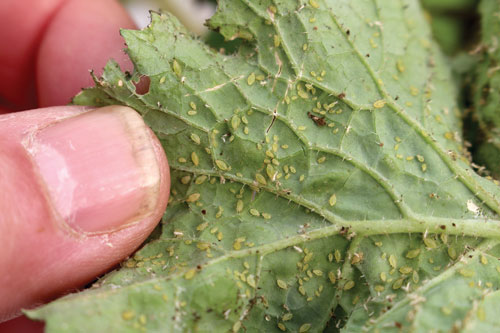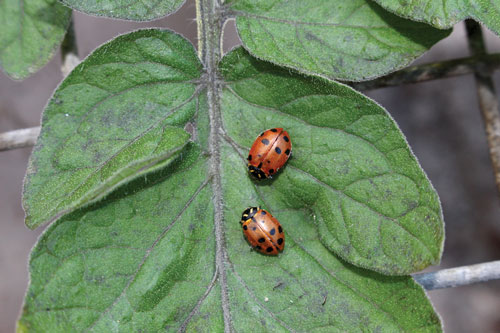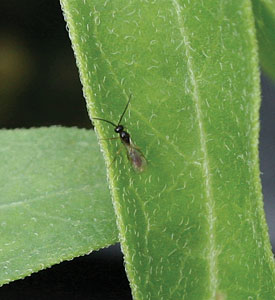6/1/2022
Non-Consumptive Effects of Biological Control Agents
Dr. Raymond A. Cloyd

Biological control agents such as parasitoids and predators are released into greenhouse production systems to manage insect pest populations below plant-damaging levels. Parasitoids and predators can directly affect insect pests through parasitism or predation (consumption). However, parasitoids and predators can indirectly affect insect pests by inducing defensive behaviors that negatively affect insect pests, often referred to as non-consumptive effects.
Pictured: Aphids will leave plants to avoid attack from parasitoids or predators.
Non-consumptive effects may be important in the biological control of insect pests by decreasing insect pest populations in the absence of parasitism or predation, thus mitigating plant damage by reducing feeding by insect pests. Insect pests stop feeding and exhibit evasive behaviors such as leaving plants and falling onto the soil/growing medium surface. However, the negative effects of insect pests leaving plants on parasitoids and predators include a reduction in the number of insect pests available and an increase in searching time or foraging behavior.
“Dropping off” plants
A common defensive behavior of insect pests is leaving (“dropping off”) plants. Leaving plants reduces the risk of mortality from foraging biological control agents such as parasitoids and/or predators. Leaving plants may be a consequence of: 1) direct contact with a parasitoid or predator; 2) sensing vibrations caused by a foraging parasitoid or predator; and/or 3) detecting alarm pheromones released by other insects.
The benefit of leaving plants is immediate escape from biological control agents, which decreases the risk of parasitism or predation. However, the disadvantages of leaving plants include: 1) increased exposure to new biological control agents; 2) reduced feeding time; and 3) increased development time and decreased reproduction. Although leaving a plant decreases the risk of parasitism or predation, feeding stops, which may reduce prey population growth. The most common insect pest that leaves plants in response to the presence of parasitoids or predators is aphids.
Aphids leaving plants
Certain aphid species, such as the potato aphid (Macrosiphum euphorbiae) and pea aphid (Acyrthosiphon pisum), leave plants to avoid attack by parasitoids or predators. However, there are risks associated with leaving plants because aphids may not be able to return to a plant, resulting in death due to starvation, and there’s the potential risk of predation by predators like ground beetles and/or rove beetles when aphids are present on the soil/growing medium surface. In addition, leaving can lead to a reduction in reproduction due to a lack of feeding on plants to obtain nutrients.
Plant height may influence aphids leaving a plant because of the potential physical damage after falling onto the soil/growing medium. In addition, aphid density may affect leaving plants as a higher aphid density may lead to a greater propensity to leave plants due to overcrowding or lack of nutritional quality of the plants.
 Pictured: Ladybird beetle adults moving on plants can cause aphids to stop feeding and leave plants.
Pictured: Ladybird beetle adults moving on plants can cause aphids to stop feeding and leave plants.
The presence of foraging parasitoids or predators may increase the number of aphids that leave plants. Leaving plants occurs more frequently as the proximity of a parasitoid or predator to an aphid decreases. Aphids can detect the presence of an approaching parasitoid or predator by sensing vibrations as the biological control agent moves on plant surfaces (leaves and stems). Aphids use vibrational cues to assess the size of a parasitoid or predator, which helps determine the potential of leaving a plant. The size of the foraging parasitoids or predators may influence whether aphids leave plants based on the intensity of plant vibrations.
Adult aphids tend to leave plants more often than nymphs do. Moreover, the difficulty in finding suitable plants may contribute to the reduced potential for aphid nymphs to leave plants. Consequently, aphid nymphs may be less likely to leave plants than adults in response to the risk of parasitism or predation.
Plant quality may affect the frequency at which aphids leave plants, as aphids feeding on low-quality plants based on nutritional value leave plants sooner and more frequently. However, the frequency of leaving plants may decline if feeding on high-nutrient quality plants is more beneficial than the cost of leaving.
Aphids warn other aphids
The main defense aphids have against attack from parasitoids and predators is to leave plants. Leaving plants may be affiliated with aphids emitting alarm pheromones, such as E-β-farnesene, in response to potential parasitism or predation. The alarm pheromone warns other aphids or conspecifics (member of the same species) on the same plant or adjacent plants that a parasitoid or predator is present so that aphids can leave plants to avoid parasitism or predation.
Predators
The non-consumptive effects on insect pests is primarily associated with predators. Predators can affect insect pests, especially aphids, without consuming them by indirectly altering their behavior by means of leaving plants. Leaving plants may influence the feeding duration, reproduction and population growth of aphids. Moreover, an unintended consequence of leaving plants is an increase in the risk of desiccation and exposure to predators that inhabit the surface of the soil/growing medium. Several factors can influence aphids leaving plants in the presence of a predator including: 1) speed of predator foraging; 2) predator proximity to aphids; and 3) contact between aphids and predator.
The predator type can influence certain aphid species leaving plants. Predators such as ladybird beetle adults and larvae may elicit aphids to leave plants. Ladybird beetle adults create vibrations when foraging on plants, which aphids use as a cue to leave plants. Aphids may sense a change in vibration frequency, which can affect leaving plants. Aphids may encounter ladybird beetle adults more frequently because they move faster than green lacewing larvae. Consequently, ladybird beetle adults cause aphids to leave plants more frequently than green lacewing larvae, which are slower moving, resulting in fewer plant vibrations.
Predator size and foraging activity can influence aphids leaving plants based on: 1) intensity of vibrations on plants produced by a predator during movement; 2) proximity of a predator to aphids; 3) volume of aphid alarm pheromone released; and/or 4) combinations of these factors. Larger and faster-moving predators create greater and more frequent vibrations on plants, thus allowing aphids to detect predators and subsequently leave plants. For example, older and larger ladybird beetle adults induce pea aphids to leave plants more frequently than younger and smaller ladybird beetle adults.
Large predators such as ladybird beetle adults and larvae may elicit a greater leaving response or induce a higher rate of aphids leaving plants than small predators, such as the insidious flower bug Orius insidiosus. Aphids may associate large predators with higher consumption rates, thus influencing the risk of predation and propensity of leaving plants.
 Pictured: Parasitoid foraging can cause aphids to stop feeding and leave plants.
Pictured: Parasitoid foraging can cause aphids to stop feeding and leave plants.
For instance, ladybird beetles cause more than three times as many aphids to leave plants than the insidious flower bug. The differences in body size and intensity of foraging (searching behavior) may be responsible for differences in the rate of leaving plants. Pea aphids leave plants more frequently when ladybird beetle adults are present compared to when lacewing larvae are present.
The prospects of leaving plants based on a perceived risk of predation are associated with predator size. In addition, predator size and foraging speed may allow aphids to assess the risk of predation based on the intensity of plant vibrations. For instance, pea aphids leave plants more frequently when exposed to ladybird beetle adults than when exposed to syrphid fly larvae due to differences in vibrations associated with predator foraging intensity. Leaving plants reduces the risk of predation by predators like ladybird beetles. The activity of predators can influence leaving plants because aphids’ sense of increased vibrations. Although aphids leaving plants may diminish the risk of consumption by ladybird beetles, leaving plants increases susceptibility to surface-foraging predators like ground and rove beetles.
Reducing the spread of plant pathogens
The non-consumptive effects of predators may indirectly reduce the spread of plant pathogens such as viruses by altering insect vector behavior, resulting in a decrease in the ability of insect vectors to transmit diseases. The non-consumptive effects of predators on insect pests like aphids and thrips that transmit viruses may affect the ability of insect vectors to become infected with, maintain and transmit infectious agents by stimulating their movement. Consequently, predation risk can affect the behavior of insect vectors, which influences acquisition of viruses by reducing the time spent ingesting phloem.
Furthermore, a decrease in feeding time diminishes transmission efficiency because aphids have to withdraw their stylets (mouthparts) before leaving a plant to escape a predator, thus reducing feeding and subsequent transmission of viruses. For example, the activity of the predatory mites, Neoseiulus cucumeris and Amblyseius swirskii may inhibit western flower thrips (Frankliniella occidentalis) adults from feeding, thus reducing the ability of adults to transmit plant viruses.
Parasitoids
Similar to predators, parasitoid foraging activity causes aphids to stop feeding and leave plants compared to when no parasitoids are present. Just like predators, aphids can sense vibrations of foraging parasitoids, resulting in aphids stopping their feeding and leaving plants.
For example, the parasitoid Aphidius colemani, when foraging reduces populations of the green peach aphid Myzus persicae by increasing the number of aphids that leave plants. In addition, adult greenhouse whitefly (Trialeurodes vaporariorum) female reproduction and longevity are reduced when nymphs are exposed to the parasitoid Encarsia formosa.
Conclusion
Although the non-consumptive effects of commercially available biological control agents released into greenhouse production systems aren’t well known, greenhouse producers should be aware of the potential non-consumptive effects of biological control agents in managing insect and mite pest populations, and subsequently reducing damage to greenhouse-grown crops. GT
Dr. Raymond A. Cloyd is a Professor and Extension Specialist in Horticultural Entomology/Plant Protection at Kansas State University. He can be reached at (785) 532-4750 or rcloyd@ksu.edu.